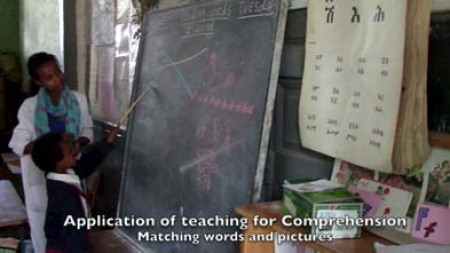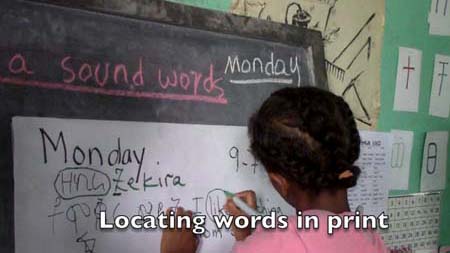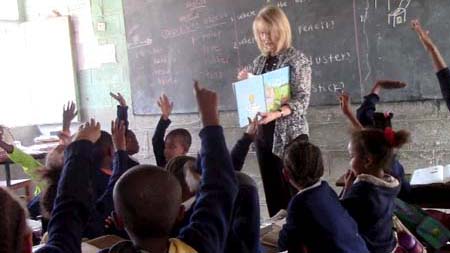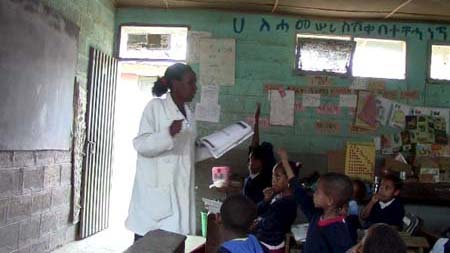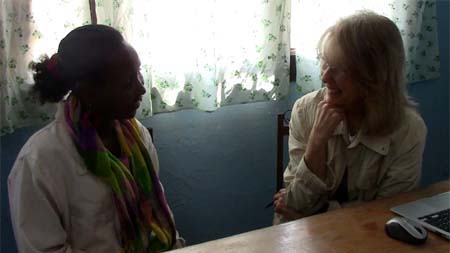|
Early Grade Reading
A message from my laptop
Collaborating with teachers whose culture and language are totally unfamiliar to you is exhilarating in its complexity and it is the perfect challenge for a lifelong educator. It is thrilling and gratifying to know that the genuine success of that collaboration will enable countless beautiful, talented youngsters, circumscribed by a narrow existence in poverty, to develop the abilities and confidence necessary for advanced education and access to the opportunities they desire.
Teacher Training Ethiopia: Kindergarten
Teacher Training Ethiopia: Grades 1 – 3
Teacher Training Ethiopia: Coaching
Inservice Overview:
Working within the economic and cultural context of the schools and the communities we serve, our model for teaching Early Grade Reading and Writing integrates literacy instruction with research-based, high-impact teaching practices that build a foundation of thoughtful, self-directed behaviors.
Our program, the teachers’ reference guide, audio recordings and video materials provide the structure necessary for novices in the teaching of reading and writing yet also invite creativity and initiative as teachers’ confidence and understanding expand.
Inservice Design:
Language Experience Approach (LEA)
The Language Experience Approach (LEA) is a research-based, time-tested method for teaching early grade literacy. Because the text (reading material) is drawn from the children’s spoken language, students experience a high rate of success and engagement. The teacher asks students to speak about their own knowledge and experiences and writes their sentences on chart paper. The students observe how their spoken words are used to create written words. This approach provides continuity between learning to read in the mother tongue and learning to read and write English. However, the CMT instructional program and teaching guide can easily be applied to any reading materials that are being used.
All the components of strong literacy learning take place within a scheduled Language Arts block of time consisting of this 6 part model of instruction:
- Daily read alouds from traditional stories and poems, picture books and children’s literature enhances learning the patterns of language, vocabulary, listening comprehension and visualization.
- Writing the LEA chart provides children with demonstrations of how letters, words and sentences are written; builds the connection between spoken and written language; and develops essential beginning reading concepts such as phonemic awareness and letter sounds.
- Rereading and shared rereading of the chart by the teacher and the students each day builds tracking skills, word recognition and fluency.
- Shared reading of the LEA chart each day engages students in learning the skills and strategies for proficient reading and writing. The teacher’s questions and participation activities are used to build letter knowledge, phonics skills, sight vocabulary, world solving ability, understanding written language, ability to locate information and habits of reading responsively and thoughtfully.
- Letter study and word study takes place as students work together to practice and extend their understanding and familiarity with letters, letter patterns and sight words.
- Independent reading and writing enables students to apply what they have learned to text they want to read and stories they want to write while developing habits of independence and self-direction.
Teachers learn multiple ways to gather information about their students’ reading and writing abilities during the daily LEA activities. Copies of the LEA charts are made so that each student receives their own copy to share with their families and to practice reading to build fluency.
Inservice Program Structure
CMT’s teacher development design provides a level of support for teachers and school leaders that cannot be obtained from workshop model inservice initiatives. Instead we work to raise professional expertise and student achievement by responding to demonstrated needs with personal engagement through one-to-one coaching.
Our program can be structured either as a cascade, or turn-key, model working with grade-level representatives or as a one-to-one coaching model, depending on the scheduling needs of the school. There are three main components to our inservice program:
Whole group meetings are reserved for (1) Discussing the overview of the inservice objectives and the presentation of support materials, (2) Planning base-line student assessment and end-of-year informal assessment, (3)Reviewing videos of teachers teaching or students learning, (4) Answering questions and solving problems common to the group and (5) Planning collaborative practices for on-going staff development.
Demonstration lessons in the classroom are preceded with an observation and discussion of the classroom dynamics and followed-up with the teacher’s application of the instructional practices that were modeled. (Video recordings are made if possible.)
Private Coaching sessions guide teachers through a process of review and reflection. With the support of the coach, teachers use student responses and their own teaching behaviors to draw conclusions, set goals and plan instruction.
Research-based, high-impact practices are integrated with the literacy instruction. Teachers learn interactive practices with students that build self-esteem, encourage self-direction and use brain-based methods for improving understanding and recall. Teachers and school leaders are provided with rubrics to monitor and evaluate their achievements.
Inservice Materials
CMT has developed print, audio and visual materials to support high-impact literacy instruction.
- The Guidebook, Read Think Write: A Teachers’ Guide to Creating Thoughtful Early Grade Readers and Writers©, is a clear and concise teaching aid that details the sequence of instruction; methods for teaching essential reading, writing and thinking strategies; instructions for supportive instructional materials, games and activities; teaching tips; and an Appendix of supporting information and teaching aids such as a guide to English letter formation and lists of common letter patterns used in early reading texts.
- The audio tapes which accompany the read-aloud books provide students and teachers with access to fluent speakers of English while the teacher displays the words and pictures in the book.
- The videos provide teachers with models of the targeted instructional strategies. In addition they demonstrate effective classroom language such as asking strategic questions, giving helpful feedback and using responses to students that encourage thought and self-direction.
Our Goal For SustainabilityOur goal is to create and sustain a core of literacy coaches at each inservice site. The coaches:
Regular reviews of the literacy coaches’ performance and effectiveness will be completed by the participating school leaders, teachers and CMT. CMT trained coaches will have a level of literacy teaching expertise that will be an asset, not only to the schools they serve but also to their own professional opportunities and to the larger educational community. |











